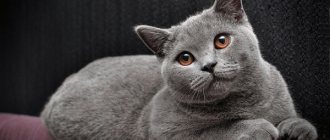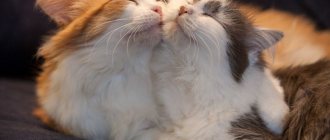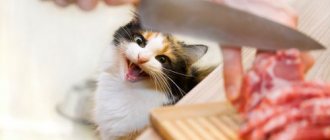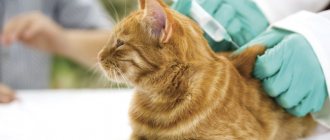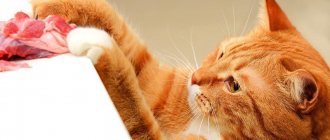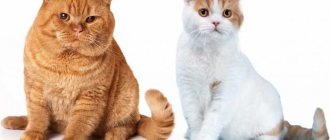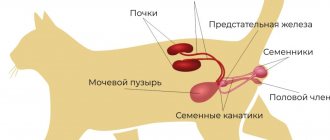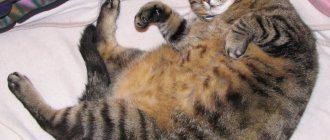In order for the mating of a British cat with a British cat to be successful, it is important to follow certain rules. First of all, you should not crossbreed at an immature age, because early pregnancy can negatively affect the health of not only the cat, but also the newborn kittens. To prevent the blue British cat from experiencing stress during mating, she must first be brought together with the groom for the purpose of getting to know each other, and only then have a cat wedding.
It is forbidden to breed a British cat with a Scottish cat, just as it is forbidden to breed a Scottish cat with a British cat. Scottish Folds have their own mating rules, but if you thoughtlessly cross representatives of different breeds, such a union can produce completely unpredictable offspring with a lot of genetic problems.
General rules
Mating of cats is carried out with the obligatory observance of the following recommendations:
- Everything should happen in the cat's territory. In this case, he will be more confident and the chances of success will increase. If you bring a cat to a cat, he will not begin his duties until he has marked the entire territory, which, of course, is not very pleasant.
- Together with the cat, you need to bring her house and the food she is used to.
- Both animals must be vaccinated. In addition, a week before mating, you need to carry out the procedure for expelling worms.
- For mating, animals are selected that are well-fed, active, and with pronounced characteristics of the breed.
- Cats need to be monitored during the procedure. There must be at least three successful cages. In this case, you can be guaranteed to get a litter. Therefore, the cat is left with the cat for 2-3 days, but no more than 4. Otherwise, some kittens may be born premature.
- You should not select partners based on advertisements. Even on Avito. Mating cats will certainly be more successful if the boy is found through the club.
- The first mating is done at the age of 1.5-2 years. Cats that are too young may have problems bearing offspring. You can’t delay the first mating either. Cats who have been nulliparous for a long time often develop problems with the reproductive system, including oncology.
Mating British cats: choosing a partner
This breed is currently one of the most popular. The British are distinguished by their large build and pleasant-to-touch “plush” coat. Their beautiful color also attracts cat lovers.
When choosing manufacturers, you should pay special attention to the last sign. Otherwise, the color of the kittens may turn out unattractive. For example, a black or blue cat would be a very good choice for a tabby cat. In this case, the babies will probably have spectacular stripes of the corresponding color on their backs. But a chocolate male is absolutely not suitable for such a lady. Otherwise, her children's fur will get a reddish tint, which is considered a disadvantage among the British. It is recommended to breed pure black or cream cats with males of exactly the same color. In this case, the pleasant shade of the animal’s fur will be retained in the offspring.
Exterior manufacturers
In addition, you should pay attention to the exterior of the manufacturers in general. You should not bring your pet with a cat that has too light a bone, a small head or a stretched body. Particular attention should be paid to the applicant's eyes. They should not be oblique. It is also not allowed to have an extra claw on any of the paws. Both of these characteristics will certainly be inherited.
Mating of British cats is usually carried out only with cats that have diplomas. The pedigree should be checked up to the fourth generation. Of course, it’s better if there are champion animals in dad’s family. You can't mix Britons with Scots.
Who is better to breed a Scottish Fold cat with?
What if you breed a Scottish cat with a British cat?
The Scots and the British do not mix. Fold-eared dogs are not mated to fold-eared dogs. It is forbidden! Dangerous! Deadly dangerous! Well, why do people who have absolutely no knowledge of the breed, genetics, or basic breeding rules try to breed cats! Do you know how difficult the Scottish breed is, what a high mortality rate they have, and how many skeletal anomalies there are. That if you choose the wrong cat, you can produce disabled people?
Breeding, yes, it is BREEDING, and not such stupid breeding that experienced breeders and felinologists should do. Tears come to my eyes when I see Scots in the veterinary clinic with fused vertebrae, with creases and wooden tails, with terrible overbites and underbites. And all this “work” of unscrupulous and nasty breeders, whose cat is leaking and screaming, and instead of castrating the cat and letting her live in peace, they drag her to the first cat they come across, often of a different breed, and get kittens like these! And then they sell them as “British Folds”, which simply DOESN’T exist! And for infections, someone checks such animals for them; such animals often do not have rabies vaccinations and they have never even seen a veterinary passport.
The British are a CLOSED breed! Breeding them with other breeds is prohibited! Scottish Folds can ONLY be bred with Scottish Straights. Before breeding a cat, you need to exhibit it at an exhibition, listen to the opinion of an expert, whether the cat corresponds to the breed, whether it has defects and problems that it can pass on to its offspring, and only after receiving a breeding assessment, the cat can be mated not with any cat, but with that which is better than her in type, which will cover all the shortcomings of the cat and pass on only the best to the offspring. Offspring
Source
Blog about British cats Everything you wanted to know about British cats and more...
How is mating done?
During heat, a British breed cat becomes restless, rubs against surrounding objects and calls for a male. Of course, she needs to find a suitable partner in advance. As soon as you notice this behavior in your pet, call the cat's owner. Mating of cats is carried out on the 2-3rd day after the start of estrus. The brought expectant mother must be left in the room where the “acquaintance” will take place for a couple of hours. This is necessary for her to get used to it. After this you can start the cat. If he does not show interest in his partner, the cat should be brought to him and her tail raised. Sometimes she herself does not want to communicate with the chosen partner - he hisses, bites and fights. In this case, it should be left in the apartment where the cat lives for a couple of days. Most likely, after a while she will get used to it, and everything will end well.
When mating, a young male cat may have to be helped to properly grasp the withers of his partner. Such animals often cling too high or low. As a result, it is inconvenient for them to do the landing and it may be wasted. The success of the procedure is determined by the cat’s behavior after it. If everything went well, she screams, then falls on her side and begins to lick her genitals.
Advice from experienced breeders
- If there is any doubt about the health of one of the animals, an additional independent examination and examination by a veterinarian may be requested before bringing them together.
- In order to successfully pair a cat with a cat, you need to give her the opportunity to get used to the environment, sniff, get comfortable and hide if necessary. She should get out of the carrier on her own.
- It is better for the cat to be in the cat’s house with its own hygiene and toilet items and eat its usual food.
- When meeting a cat, the owner must be prepared for aggressive behavior of animals. To breed overly aggressive individuals, special enclosures are used, from where the animals get to know each other, and then go out and mate on their own.
- It is better to leave partners with full confidence in the established mutual understanding and agreement between them.
- After fertilization, the male loses interest in the female; from this behavior you can understand that the cat can already be taken home.
- If after the first mating the cat fails to become pregnant, then the mating should be repeated when a new heat occurs.
In order to successfully match a cat with a cat, it is necessary to exclude some points and features - the discrepancy in the size of the animals, when it is difficult for them to have sexual intercourse with each other from a physiological point of view. This feature is often possessed by males of the British breed, which are much more massive and larger than females. It will not be possible to breed a cat with a male if the female representative suddenly loses signs of heat, or she completely stops flowing at the time of mating.
It can be very difficult to match a cat with a cat, but intuition and love for animals will help you successfully cope with the task. A worthy reward for complex and responsible work will be the birth of high-quality and healthy offspring!
Sources
- https://MoiKoty.ru/porody/britanskie/vyazka-koshek
- https://WikiCat.ru/porody/vyazka-britanskih-koshek-435/
- https://kot-i-koshka.ru/vyazka-koshek/
- https://DogBuldog.ru/koty/poroda/vyazka-britanskih-4055/
- https://VashiKoshki.ru/zdorove/beremennost-i-rody-u-britanskoj-koshki
- https://samila-rich.ru/sovety/vyazka-britanskih-koshek-pravila.html
- https://brit-cats.ru/prodolzhenie-roda/vyazka-britanskix-koshek-osnovnye-pravila-dlya-vladelcev/
- https://natalyland.ru/kogda-mozno-svodit-britanskuu-kosku-s-kotom/
[collapse]
Scottish Mating
At the moment, two varieties of cats of this breed are bred - fold-eared and with straight regular ears. One of the basic rules of mating in this case is that the former must be mated only with the latter. This means that fold-eared cats cannot be crossed with cats of the same type. This is due to the fact that this breed is very young and has not yet established itself. With such crossing, kittens can be born with various types of defects. Fortunately, individuals with straight ears are always carriers of the lop-eared gene. As already mentioned, mating of Scottish cats with British cats is not allowed. The fact is that the latter have a more powerful constitution. Therefore, crossing can lead to the appearance of kittens with musculoskeletal disorders.
Theoretically, a lop-eared girl, after “meeting” a partner with straight ears, should have about 4 lop-eared kittens in her litter. In practice, sometimes 1-2 kittens are born, sometimes all babies have this trait, etc. That is, it is impossible to accurately predict the number of Scottish Folds. Of course, it is impossible to determine the baby’s exterior features in this regard immediately after birth. Fold ear appears approximately on the 18th day after birth. Mating of fold cats, as you can see, is not a very troublesome procedure in terms of a partner, but does not have a predictable result.
Mating of sphinxes
The basic rule for selecting a partner in this case is that you cannot cross hairless animals with hairless ones. Such a cat should choose a “velor” or “brush” partner. Otherwise, the offspring may develop various kinds of genetic diseases. Mating of Sphynx cats can only be done after the female partner has gone through her first two heats. However, it is also not recommended to delay this procedure. A Sphynx cat should be paired with a cat before the age of 1.5 years, since puberty occurs quite early in representatives of this breed.
This is how cats of different breeds are mated. By observing the conditions for selecting partners and the rules of mating itself, you can actually get good offspring and make good money. Pedigree kittens are quite expensive these days.
Features of caring for an animal during pregnancy
The first signs of pregnancy in a British woman are changes in appetite and taste preferences, sudden changes in mood, morning sickness or vomiting, swelling and pinking of the nipples. Approximately two weeks after mating, pregnancy is already diagnosed using ultrasound. The veterinarian can also determine it by palpation. You cannot feel the cat’s belly yourself, so as not to injure the embryos.
An important question for beginners: how long does pregnancy last for British cats. On average, this period is 63–65 days. A young or delicate animal can give birth earlier - on days 56–60, while a large one, on the contrary, can give birth later. The number of kittens in the litter also matters: the fewer there are, the longer the gestation will take.
Pregnancy in British cats is usually easy, but the animal must be shown to the veterinarian at least twice so as not to miss possible complications.
A pregnant cat needs a balanced diet with a high calcium content. At this time, it is impossible to transfer the animal from natural food to industrial food, and vice versa.
A natural diet should include a large amount of protein: lean meat, dairy products. Industrial food should be chosen as super-premium, designed specifically for pregnant cats.
Meals should be fractional, in small portions. Gradually, the daily amount of food should be increased, but overfeeding should be avoided (this breed is prone to obesity).
Make sure that your British cat does not climb high up and especially does not jump from the furniture - due to a shift in the center of gravity, she becomes awkward and may be injured. It is better not to pick up the cat at this time, or to hold it under the chest and butt so as not to touch the stomach.
The animal should be protected from stress: fear or a state of constant anxiety can cause both premature birth and its delay.



